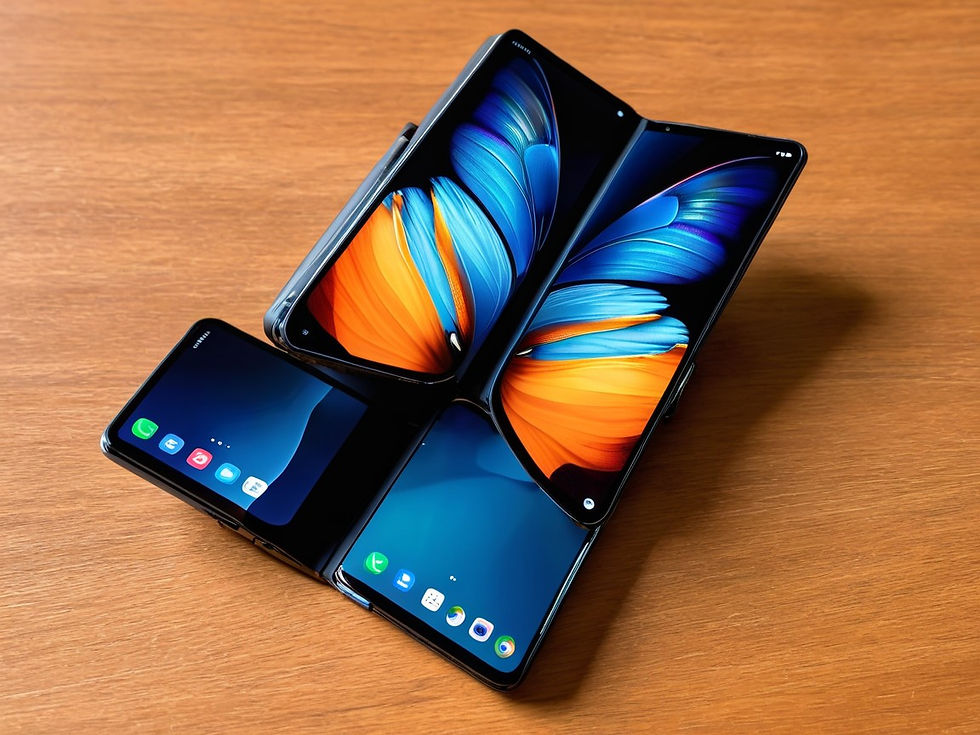Exploring the Drawbacks of 5G Foldable Smartphones
- Leke Folorunsho
- Jan 16, 2025
- 4 min read
Foldable smartphones have emerged as one of the most fascinating developments. These devices, which promise portability as well as a larger display, appeal to both tech enthusiasts and general consumers. However, while their futuristic form and possible functionality are appealing, it is critical to investigate the limitations of foldable phones.
This investigation will not only emphasize problems about durability, cost, software compatibility, and market adoption, but also investigate how these constraints may inhibit their success in a competitive market.
One of the major limitations of foldable phones is their durability. Traditional smartphones are built to withstand daily wear and tear, but foldable handsets pose unique issues due to their moving parts and flexible screens.

Foldable displays are frequently constructed of sensitive materials that are susceptible to scratches and damage. Despite technological breakthroughs like as the use of ultra-thin glass, these screens are still not as durable as traditional smartphone displays. Users have experienced screen scratches even after modest use, raising questions about their long-term reliability hinges and Mechanisms.
Another source of vulnerability is the mechanical hinge systems that enable the folding capability. Over time, these hinges may wear down, resulting in failure or a less smooth opening and closing experience. Many people are hesitant to invest in a foldable smartphone because they are concerned about breaking it after a few months of use.
Cost Implications and Accessibility of Foldable Smartphones
Another significant issue with foldable devices is their pricing. Many foldable devices were introduced at a premium price, reflecting their cutting-edge design and technology.
Foldable smartphones are prohibitively expensive for many customers. While flagship handsets have traditionally been pricey, foldable smartphones frequently exceed these prices by a wide margin. This expense alienates a sizable portion of the market, particularly budget-conscious buyers who may seek less expensive options without compromising essential features.
Software Compatibility and App Optimization Issues
The move from typical flat displays to foldable panels has ramifications beyond technology; software optimization is essential to the user experience. Unfortunately, this is a persistent difficulty for producers.
While many apps have been updated to handle larger screens, there are still a variety of programs that do not fully realize the promise of foldable devices. Users frequently encounter sub-optimal experiences, such as odd layouts or functionality that fails when switching between the unfolded and folded modes. This disparity may cause aggravation and unhappiness, overshadowing the novelty of possessing a foldable smartphone.
As manufacturers release new foldable models with varying capabilities and screen sizes, software fragmentation becomes a major worry. Developers must negotiate several device versions, which can cause delays in updates and cross-platform support, resulting in an uneven user experience.
The Market Adoption Challenges of Foldable Phones
Despite the hype surrounding foldable phones, market acceptance has not been as swift as some manufacturers predicted. Several reasons contribute to the lukewarm response.
Many consumers are skeptical of the concept of a foldable smartphone because it is still novel to them. Many potential purchasers are hesitant to invest in unproven technologies due to concerns about the hazards involved. Early adopters frequently serve as barometers for broader adoption; if they encounter problems or share unfavorable experiences, the reticence might spread to the general public.
The present ecosystem for foldable Smartphones is limited. While standard smartphones have a wide range of accessories, features, and software designed to improve the user experience, foldables lack such mature support. The niche market may grow slowly, as developers and accessory makers
Before committing resources to innovation in this field, we should wait for a larger user base
User Experience Challenges
Foldable smartphones have amazing features and beautiful looks, but real-world use typically reveals underlying flaws that might limit usability.

While the concept of integrating a phone and a tablet into one device is enticing, practical considerations such as weight and thickness come into play. Some foldable devices seem heavier and thicker than their standard equivalents, which may put off consumers who like lightweight and thin designs.
Battery life in foldable smartphones has also been an issue. With the extra complexity of larger screens and advanced functionality, manufacturers may struggle to deliver appropriate battery capacity. Users may find themselves charging such gadgets more frequently than normal smartphones, reducing the convenience factor expected from mobile technology.
Value Proposition
Furthermore, potential purchasers may doubt the worth of investing in a foldable smartphone vs regular versions. Because the majority of users rely on their phones for calling, messaging, and social media, many may find the additional expense unreasonable given that ordinary smartphones may meet their demands adequately.
Conclusion
foldable smartphones continue to hit the market, their potential to transform how we engage with technology is apparent. However, a careful evaluation of their disadvantages exposes considerable obstacles that both manufacturers and customers must face.
Durability concerns and high price points, as well as software compatibility and user experience issues, remain significant barriers to wider adoption. As innovation continues to transform the smartphone market, tackling these issues will be important to the future of foldable smartphones.
To enhance the appeal of foldable smartphones, manufacturers must prioritize durability, software optimization, and overall user experience refinement. Until then, while foldable smartphones remain a fascinating view into the future of technology, many buyers may perceive them as a dangerous purchase.
The evolution of foldable phones serves as a reminder that even the most exciting breakthroughs are fraught with obstacles. By learning from these early iterations, the tech sector can get closer to designing products that not only look great but also suit our daily requirements.




Comments